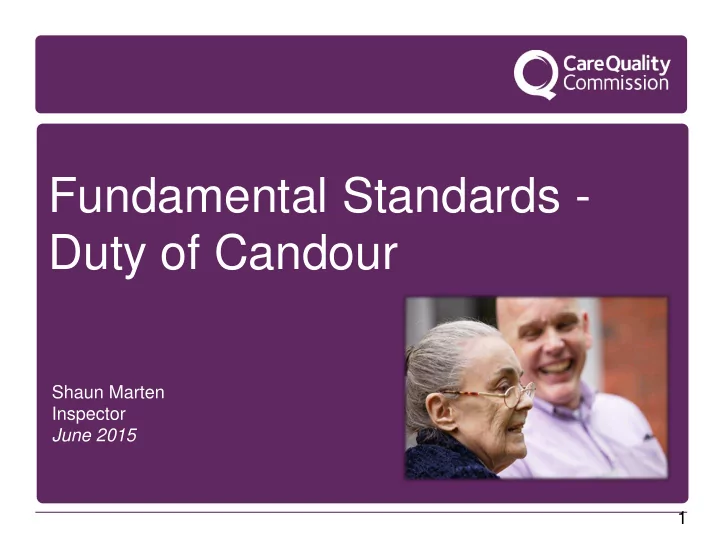

Fundamental Standards - Duty of Candour Shaun Marten Inspector June 2015 1
CQC purpose and role Our purpose We make sure health and social care services provide people with safe, effective, compassionate, high-quality care and we encourage care services to improve Our role We monitor, inspect and regulate services to make sure they meet fundamental standards of quality and safety and we publish what we find, including performance ratings to help people choose care 2
Regulation to inspire improvement What we do: Set clear expectations Monitor and inspect Publish and rate Celebrate success Tackle failure Signpost help Influence debate Work in partnership 3
Fundamental standards Care and welfare of service users Assessing and monitoring the quality Person-centred care Previous Regulations of service provision Dignity and respect Safeguarding service users from Need for consent New Regulations abuse Safe care and treatment Cleanliness and infection control Safeguarding service users from Management of medicines abuse Meeting nutritional needs Meeting nutritional needs Safety and suitability of premises Cleanliness, safety and suitability Safety and suitability of equipment of premises and equipment Respecting and involving service Receiving and acting on complaints users Good governance Consent to care and treatment Staffing Complaints Fit and proper persons employed Records and Requirements relating to workers Fit and proper persons requirement Staffing for directors Supporting workers Duty of candour Cooperating with other providers 4
New for April 2015 Fundamental standards Fit and proper person requirement Duty of candour Special measures Scores on the doors Market oversight 5
Duty of candour Purpose Promotes adoption of openness and transparency in services Supports development of safety culture Actions for providers Inform people when things go wrong Provide support, truthful information & apology CQC Registration Inspection – existing key lines of enquiry 6
What does the regulation say? Registered persons must act in an open and transparent way with relevant persons As soon as reasonably practicable after becoming aware that a notifiable safety incident has occurred a registered person must notify the relevant person that the incident has occurred in person Provide reasonable support to the relevant person in relation to the incident Personal notification must be followed up by a written notification given or sent to the relevant person The registered provider must securely keep a copy of all correspondence with the relevant person, including instances where the relevant person could not be contacted, or declined to speak with the provider 7
What is a notifiable safety incident? An unintended or unexpected incident occurring during the provision of a regulated activity that could result in, or appears to have resulted in: Death, where it relates directly to the incident Severe harm (which means a permanent lessening of bodily, sensory, motor, physiologic or intellectual functions) Moderate harm (which means harm that requires a moderate increase in treatment or significant, but not permanent, harm) Prolonged psychological harm 8
What must notifications contain? A truthful account of all the facts, as they are known at the time Details what further enquiries into the incident the provider believes are appropriate An apology 9
Guidance for providers on meeting the regulations (March 2015) Providers should have policies and procedures in place to support a culture of openness and transparency, and ensure that all staff follow them Providers should have a system in place to identify and deal with possible breaches of the professional duty of candour by staff who are professionally registered Staff should receive appropriate training and support All staff have a responsibility to adhere to that organisation's policies around duty of candour, regardless of seniority or permanency Information should only be disclosed to family members or carers where the person using the service has given their consent ( with exceptions ) 10
Guidance (Continued) The account of relevant facts should include as much or as little information as the relevant person wants to hear, be jargon free and explain any complicated terms Consideration should be given to seniority, relationship to the person using the service, and experience and expertise in the type of notifiable incident that has occurred when making a decision about the most appropriate person to provide the notification Providers must give the relevant person all reasonable support necessary to help overcome the physical, psychological and emotional impact of the incident ( examples given ) The outcomes or results of any further enquiries and investigations must also be provided in writing to the relevant person through further written notifications 11
How will we enforce the regulation? Civil enforcement powers Criminal powers • Impose, vary or remove • Requirements • Penalty notices conditions of registration (formerly known as • Simple cautions • Suspension of registration compliance actions) • Prosecutions • Cancellation of • Warning notices registration • S.28 warning notices Holding individuals to • Urgent procedures account • Fit and proper person Failing services requirement • Immediate action to • Prosecution of protect from harm Protect people who use individuals • Time- limited ‘final chance’ services by requiring • Coordination with other improvement oversight bodies Hold providers to account Severity for failure Protect people who use services by requiring improvement 12
Questions? 13
Recommend
More recommend